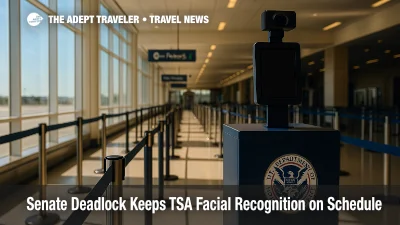Senate Deadlock Keeps TSA Facial Recognition on Schedule

A Senate Commerce Committee stalemate has sidelined a bipartisan bill that sought to pause new airport face-scan checkpoints. The setback clears the runway for the Transportation Security Administration to extend TSA facial recognition to more PreCheck and standard lanes before the busy winter-holiday travel period. Privacy advocates warn the technology is outpacing safeguards, while airlines hail faster throughput. With no markup rescheduled, only a full-chamber push can revive the measure this session.
Key Points
- Why it matters: Congressional inaction lets biometric lanes reach hundreds of airports by year-end.
- Travel impact: Opt-out remains, but staff may steer travelers toward scans, raising privacy concerns.
- What's next: Sponsors eye floor amendments; DHS audit on data handling due this fall.
- Industry angle: Airlines and vendors argue the bill would snarl checkpoints and budgets.
- Watch list: Expansion already planned at ATL, LAX, and ORD before Thanksgiving.
Snapshot
The Traveler Privacy Protection Act, introduced in May by Senators Jeff Merkley and John Kennedy, would have required traditional ID checks as the default and mandated immediate deletion of biometric data. Face-scan units now operate at 84 airports and, according to TSA, can confirm identity in under two seconds while cutting false-ID catches by half. The agency's rollout plan envisions more than 400 installations by late 2026. Details on the process and opt-out are posted on the TSA identity-verification page.
Background
Biometric screening entered pilot use at U.S. airports in 2017, piggybacking on existing Customs exit programs. By 2023 the agency had tested systems at major hubs such as Hartsfield-Jackson Atlanta International Airport (ATL), Los Angeles International Airport (LAX), and Chicago O'Hare International Airport (ORD). Early trials limited scans to PreCheck travelers willing to try a paperless boarding-pass flow. Civil-liberties groups quickly argued that unclear signage and staff pressure eroded genuine consent. In response, TSA adopted a verbal disclosure policy and added written opt-out notices, but critics say enforcement is inconsistent. The stalled Senate bill attempted to codify opt-in rules, cap data retention at zero days, and bar secondary data uses without congressional approval.
Latest Developments
Lobbying Drive Preserves TSA Facial Recognition Rollout
Committee staff say a late surge of letters from airline, airport, and travel-tech associations fueled doubts over potential checkpoint delays if the bill advanced. Lawmakers also cite a behind-the-scenes push by TSA officials defending current timelines. The combined effort convinced Chair Ted Cruz to pull the measure from last week's markup agenda, Politico reported. Sponsors now consider attaching privacy language to forthcoming FAA reauthorization or DHS appropriation bills. Meanwhile, TSA plans to activate additional biometric lanes at ten large and fifteen midsize airports before November 21. Absent statutory guardrails, opt-out will remain policy rather than mandate, and data-deletion practices will rely on agency discretion. Read Politico's full account here.
Analysis
Congressional fights over security technology often pit speed against civil liberties. Supporters view face-scan gates as a rare win-win, shaving seconds while thwarting impostors. Yet biometric authentication carries baked-in surveillance risk because the credential is inseparable from the traveler's body. Without strict limits, databases can be repurposed, breached, or quietly shared. The stalled bill tried to square that circle with opt-in, deletion, and transparency, mirroring European data-protection norms rather than banning the tool outright. Industry lobbying framed the measure as a jobs-killer that would force TSA to add thousands of manual-ID officers just as budget cuts loom. By allowing the program to proceed, lawmakers have deferred the privacy question to regulators and the courts, a familiar pattern since 9-11. Travelers now carry the burden of vigilance, needing to affirmatively request manual checks even when signage is ambiguous. If adoption accelerates to the projected 400-airport mark, biometric scanning could shift from optional perk to perceived prerequisite, making future roll-backs politically harder. The coming DHS inspector-general audit will thus shape whether Congress revisits the issue with stronger momentum or lets agency policy stand as de facto law.
Final Thoughts
For now, the TSA facial recognition expansion remains on autopilot, powered by industry enthusiasm and congressional inertia. Travelers concerned about privacy should rehearse the opt-out script, monitor TSA signage, and watch for the inspector-general report. Unless lawmakers force a course correction, face-scan lanes may become as ubiquitous as shoe removal, embedding TSA facial recognition in routine airport life.
Sources
- Senate Republicans not backing down in battle with TSA over facial recognition bill, Politico
- US airlines oppose new limits on facial recognition at airport checkpoints, Reuters
- More airports are scanning faces. A new bill would limit the practice, The Washington Post
- Clash over TSA biometric expansion heats up as privacy bill derailed in Senate, Biometric Update
- Identity Verification at Airport Security, TSA
